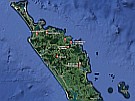Videos are filmed each day on the field trip and edited each night. They are linked here during the field trip.
For help and more information about LEARNZ videos, go to Help with Videos in the LEARNZ Support section.
Video question sheet - Word (31k) | PDF (217k) | Google Doc to use for each video (based on SOLO Taxonomy).
Mangahāwea videos
The following two videos were recorded earlier this year at Mangahāwea during the archaeological excavation.
mangahawea-te-reo-english from LEARNZ on Vimeo. In this video, Kipa Munro talks with two young uri/descendants of Ngāti Kuta and Patukeha about their experience assisting with the Mangahāwea archaeological excavation. NB: Video is in English and te reo Māori.
mangahawea-english from LEARNZ on Vimeo. In this video, Andrew talks with John/Hone about his connection to Mangahāwea and how he has contributed to the Mangahāwea archaeological excavation.
Monday 9 September
1. Journey to Mangahāwea
Jump aboard the water taxi at Russell wharf for a boat ride to Moturua Island. Here you trek over the hill to Mangahāwea Bay, one of the earliest sites of human habitation in Aotearoa.
2. First Arrivals on Mangahāwea
Why Mangahāwea? Early Polynesian explorers didn’t just come ashore to Mangahāwea by chance. Andrew Blanshard explains why they would have chosen this spot and how various parts of the bay and greater island would have served their needs for survival.
3. Archaeology and looking back in time at Mangahāwea
You are at Mangahāwea Bay. DOC archaeologist Andrew Blanshard takes you to the spot where in the late 1970s, a member of the public first spotted part of what turned out to be a large hāngi pit. It was from this discovery that the first excavation in the early 1980s took place. Andrew gives an overview of the excavations and what they have uncovered about early human occupation of Mangahāwea.
4. Painting a Picture of the Past
What would the village at Mangahāwea have looked like? Andrew Blanshard gives a general description of village life based on archaeological evidence. As you watch the video, see if you can paint a picture in your mind’s eye of how it might have looked.
Tuesday 10 September
1. On Board the R Tucker Thompson
You are with Kate Martin from Russell Museum/Te Whare Taonga o Kororāreka on board the R Tucker Thompson. Number one in a series of four videos from today about the first encounters between Māori and Europeans in Te Pēwhairangi/Bay of Islands in 1769, Kate details the initial gift giving exchange that took place on board the Endeavour. Due to a misunderstanding between the two parties, things didn’t go as smoothly as they could have…
2. When Cook and his Crew went Ashore
You are at Russell Museum/Te Whare Taonga o Kororāreka with Kate Martin. Kate continues the story of the first meeting between Māori and Europeans in the Bay of Islands/Te Pēwhairangi in 1769. In this video we learn what happened when Captain Cook and some of the crew went ashore to Otarepo on Motuarohia.
3. Preparing to Leave Te Pēwhairangi
Kate Martin uses a map of Īpipiri (an early name for the Bay of Islands) to show what Cook and his crew did during the rest of their seven day stay in the Bay.
4. The Importance of Tupaia
Tupaia, a High Priest navigator from Polynesia, “disappeared” for four days while Cook and his crew were getting ready to sail again. Where did he go? What did he do? And what was significant about his presence here in Te Pēwhairangi at that time?
Wednesday 11 September
1. The changing landscape of Te Pēwhairangi
Ria Bright from Project Island Song talks with Andrew about how the Bay of Islands environment has changed over time, particularly since the arrival of people. How does our changing environment affect us as a community? What role does conservation play in shaping our identity as New Zealanders?
2. Restoration planting
Join students from Te Kura o Waikare and Russell School at Long Beach/Oneroa for some dune restoration. How does this example of environmental damage compare with areas near your place? What part can you play to help restore your local environment? What benefits will this restoration bring?
3. Karakia Te Pū
Andrew shares his thoughts from the field trip. Then, students from Te Kura o Waikare and Russell School finish the field trip with a karakia. You could learn the words, meaning, and actions for this karakia by downloading the following PDF: Karakia Te Pū - PDF (180k).




